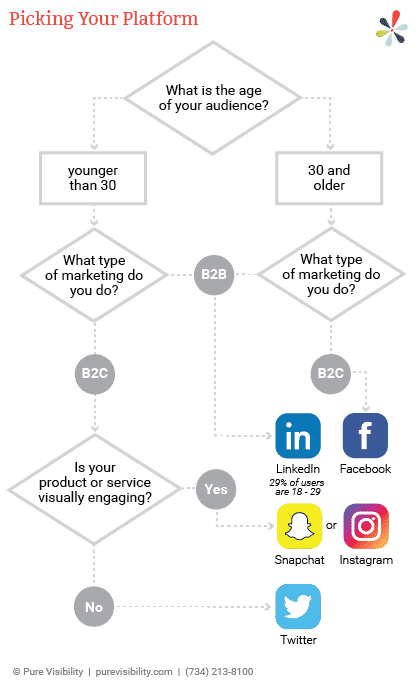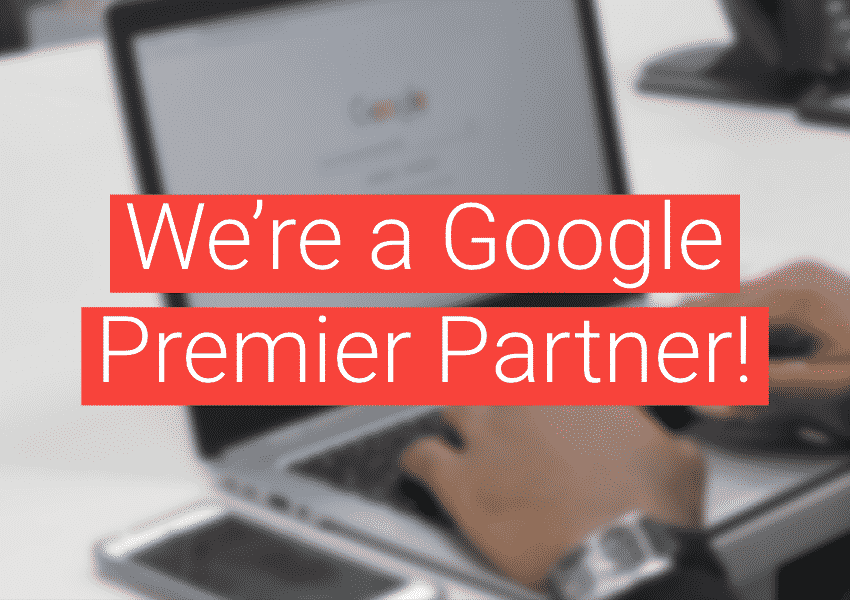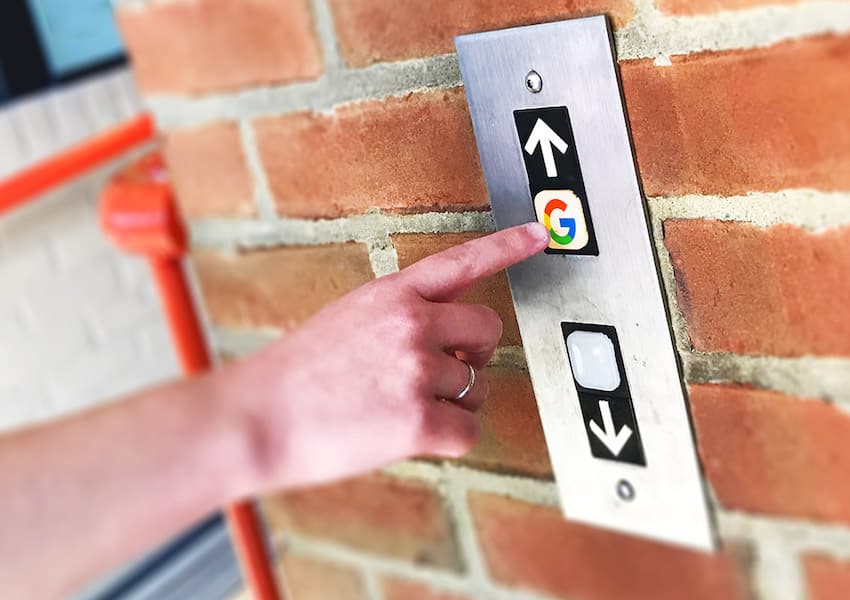It’s easy to feel like social media is only for beauty influencers, teenage girls, and washed-up celebrities. But with so many platforms to choose from, there’s one that’s right for your business goals and demographic. Our helpful infographic will show you how to match the social medium to your message.
Social media basics
Social media marketing, just like any other tactic, needs a good strategy in order to work for you. Most important to your strategy is a clear goal; for example, do you want more people to know about your brand, or download your app, or go visit your blog? Each of these goals has a different ideal platform. Using the wrong one can mean little to no return for your efforts. Although organic social media is free, the labor put into maintaining multiple channels is not insignificant. It takes regular upkeep to make sure everything’s running optimally, and that nothing is being buried by the various social media algorithms. So, to achieve social media success, it’s vital to consider which platform is best for reaching your audience and achieving your goals.
So…what’s the algorithm?
The first thing to know about “the algorithm” is that there is not just one. Each platform has its own algorithm, although they all function in a similar way. Social media, just like any online business, is focused on user experience. Typically, users are looking for more posts from friends and family and fewer from businesses. This does not mean that Facebook, Twitter, and Instagram are purposely burying the content you produce. What it does mean is that if your content has little to no engagement, eventually that content will not be shown in your audience’s feeds—the platform interprets low numbers of likes, shares, and comments as user disinterest.
Can the algorithm help me?
Of course! If your page is producing stellar content that engages your audience consistently, not only will it continue to be shown at the top of feeds, but it will also appear to users who don’t follow your account but match the demographics of your already-engaged audience. Some platforms can suggest certain posts to specific users, or even suggest that a user like your entire page. It’s free advertising!
The 5 best social media platforms for business
Let’s take a closer look at the most popular social media platforms, what some of their strengths and weakness are, and what types of audiences they appeal to. We’ll also give you bite-sized best practices for each, helping you decide where to invest your social media efforts.
This social media titan has been going strong since 2004, and shows no signs of slowing down in terms of user growth or new acquisitions (Facebook purchased Instagram for $1 billion in 2012). Gone are the days of needing a .edu email to start a Facebook profile—the demographic is quite the opposite, actually. Individuals 30-50 years old have taken over as the most active users of the site, making Facebook ideal for anyone looking to market to families, new parents, or professionals with disposable income (over 75% of Facebook users have an income greater than $75,000).
Facebook is also an ideal platform for promoting an event being hosted or attended by your company. The platform offers specific pages for events, complete with separate demographic insights. People can invite friends, RSVP, and purchase tickets right from Facebook, eliminating the need to use multiple sites for the same event.
Above all else, be sure to post engaging content. Facebook is notorious for their strict algorithm that could mean your stellar content isn’t being seen! Start off posting one to two times per week, then gradually move up from there, as long as you have your desired engagement rate.

Twitter is the golden child of the tech and news industries, and for good reason. People turn to Twitter to get 140-character reports on everything from the newest iPhone to political affairs around the world. If you are looking to become a thought leader, then this platform is the perfect place to grow your brand. However, Twitter falls short when it comes to generating sales. If your goals involve online or in-store purchases, don’t rely on Twitter alone. Use it to amplify other social media channels that are better suited for driving sales.
Twitter has also become the new choice for customer service. Users who tweet at companies directly expect a response in less than 24 hours. Responding quickly to social media reviews, both positive and negative, reflects well on a brand. If you choose to be active on Twitter, make sure you have a social media manager or intern that is ready to respond to tweets, at the very least, during normal business hours.
Due to Twitter’s constantly refreshing nature, we recommend posting here three to four times per week. A good idea is to tweet original content that your company has created as well as other industry-relevant news curated from different sources.
If your company or brand has a visually-appealing story to tell, then Instagram’s graphics-focused platform is an ideal addition to your organic social media strategy. You will benefit the most from Instagram if your audience is under age 30, and you have the capability to produce high-quality images. Instagram is a great place to explore the creative side of your team’s content-producing capabilities—show off the city you are based in, highlight office culture—the sky’s the limit for this artistic platform.
Instagram’s Stories feature is also a great way to produce more in-depth content that doesn’t overwhelm your followers’ feeds. These “stories” are comprised of a series of photos and/or videos that last for only 24 hours and can link to external websites or other social media platforms. This linking capability within Stories is a crucial feature for businesses, since links cannot be included in organic Instagram posts, and users are limited to only one link in their Instagram bio.
Best practice for businesses on Instagram is to also have a Facebook business profile; it will make both organic and paid social posting easier. If you are looking to gain some insight into the people following you, linking Instagram to your Facebook page allows you to see the demographics of your followers, including where they are from and some of their key interests. Additionally, if you decide to start advertising on this visual platform, you can do so right from your already-established Facebook Business Manager account.
In general, users on Instagram do not post as frequently as on other platforms, so don’t overwhelm them by posting multiple times per week. Instead, shoot for one to two times per month. For Stories, however, there is no specific best practice on how often to post. A benefit of Instagram’s lower activity levels is that you can update a Story more frequently without losing audience engagement. Be sure your photos and videos are as high-quality as possible!
Snapchat
The most important thing to know about Snapchat is that unless your audience is younger than 30, it will be very difficult to garner a lot of engagement. That being said, if your audience is using this platform, they are surely active on it. Compared to Instagram, Snapchat is slightly more labor-intensive to put to work as part of a marketing strategy. Be prepared to make multiple Story updates, at least 3 times per week. We recommend putting together a content calendar to plan a week’s or month’s worth of Story ideas that typify your brand and correspond to company events or promotions.
Best practice with Snapchat is to establish a social media presence elsewhere, such as Instagram or Twitter, targeted for a younger audience, and then cross-promote your Snapchat account. This helps you gain broader exposure and find new followers, since Snapchat does not have a feed where users would otherwise see your content if they are not following you.
It’s not just for recruiting anymore! LinkedIn is quickly growing as a popular social media platform, with the added bonus that its professional nature makes it more trustworthy to its users. If you are a B2B company, it is crucial that you have a professional LinkedIn page, and that it is well-stocked with industry news, company insights, and accolades for your brand.
Like Twitter, posting on LinkedIn is all about displaying thought leadership and drawing like-minded professionals to your company for up-to-date knowledge on industry issues. As a general recommendation, we suggest posting here one to two times per week at first, then gradually increasing post rate as engagement increases.
Final thoughts
Implementing a social media marketing strategy can be an overwhelming new goal, but it is surely a laudable one. The main secret to success? Make sure you know what platform is right for you, then post interesting, insightful, and relevant content; you’ll be on your way to a solid follower base in no time!
Don’t have a constant font of original content? No problem! Sites like buzzsumo.com are great for finding industry-relevant content for you to share with your followers. Additionally, it is recommended to use platform aggregators like Sprout Social or Hootsuite for ease of posting — queue up content to be posted sporadically, or plan out posts for up to a month leading up to an event.
Don’t be discouraged if you don’t achieve overnight virality—effective social media use is about quality, not quantity. Make sure the people you are attracting are true leads that could benefit your business later. It is important to create content that is engaging, but still true to your brand and attracts your ideal audience. Look at the profiles of some of your competitors for inspiration, and be prepared to rework your strategy if you see that certain tactics are not helping you reach your goals.
Still not sure which platform is right for you?
Check out our awesome flowchart (above) to determine where you should be investing your social media efforts. And be sure to follow Pure Visibility on Facebook, Twitter, Instagram, and LinkedIn!




